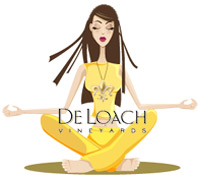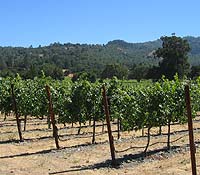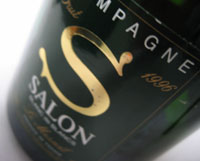|

2006 Fall/Winter Wine News
 More 2006 Wine News
More 2006 Wine News
 Latest Wine News Latest Wine News
December
26, 2006
Winemaker
Turns Fire-Damaged Wine into BBQ Sauce
As
the old adage goes, "When life hands you lemons, make lemonade."
For Tres
Sabores winery owner Julie Johnson, when life handed her cases
of fire-damaged wine, she decided to make barbecue
sauce. Hers was one of about 80 Napa
and Sonoma wineries that collectively had roughly 600,000 cases
of wine stored in a temperature-controlled warehouse that was
set on fire by an arsonist October of 2005. Losses—mainly
ruined wine—have been estimated at $100 million, while Johnson
lost nearly 2,000 cases, including an entire vintage. Using about
5,000 of recovered intact bottles to make her "Porque No?"
sauce won’t recover that loss for Johnson, but she says,
"I wanted to make something positive out of this, so I made
a ‘fire roasted’ Zinfandel,
persimmons and pomegranate marinade and barbecue glaze. It’s
my way of dealing with it." In another less-tasty example
of making the best of a bad situation, over 100,000 cases of ruined
wine from a number of wineries have been converted into ethanol.
December
19, 2006
Wineries
See the Light in Switching to Solar
|
Solar
panels are placed atop Merryvale's Starmont Winery |
With
a never-ending supply of California sunshine, an increasing number
of Golden State wineries are installing solar panels to power
their winemaking endeavors. Recently, three Napa wineries have
joined a dozen or so others in this earth-friendly transformation.
For Merryvale Vineyards, which was the first to open in Napa after
Prohibition, almost 100 percent of the energy for their new Starmont
Winery will be produced by a 277kW solar system that includes
panels placed atop 60,000-square-feet of winery building rooftops.
In addition to eventually saving a significant amount of money
on energy, there is a significant environmental impact in switching
to solar. Merryvale’s new system will eliminate almost 473
tons of greenhouse gases per year, or the equivalent of driving
one million miles.
“Solar
energy is good for the environment and the reduction of greenhouse
gases is good for the community,” said Alex Gunst, the construction
manager for Merryvale’s new wine facility. “With rising
energy costs and the generous rebates currently offered, going
solar was an easy decision.”
These rebates come from power companies, but also include tax
credits from the federal and state governments. Honig
Winery’s solar system, which features panels located
amongst the vines, cost $1.2 million, much of which was covered
by rebates and tax credits. Solar systems like Honig’s and
Merryvale’s will last for decades and, after only five to
eight years, will essentially provide free energy for power-intensive
winemaking activities like chilling, crushing and bottling.
December
14, 2006
Pernod
Ricard Announces $1,000 Champagne
Rappers
had better come up with something that rhymes with “Belle
Epoque,” because Pernod Ricard is set to establish a new
price threshold in the premium
Champagne business. The French wine and spirits group plans
on releasing a new sparkler that will cost a staggering €1,000
or $1,320—a price usually reserved for rare, older bottles.
Company chairman Patrick Ricard hinted that it will be launched
under Perrier-Jouët’s Belle Epoque brand, which currently
tops out at around $90. The company hopes to move its brands more
upscale as they compete for market share against larger luxury
Champagne groups like LVMH, which owns Moët & Chandon,
Krug and Dom Pérignon.
“It
is a fact that consumers all over the world want to identify with
brands that represent themselves,” Pernod Ricard managing
director Pierre Pringuet said. “This has to be brands with
quality, which are exclusive. It’s the same for fashion,
cars and spirits.”
December
7, 2006
Winery
Donates Funds to Same-Sex Marriage Group
While
buying Plumpjack
wine may indicate you support the politics of owner/San Francisco
Mayor Gavin Newsom, buying Seduction wine means you are definitely
supporting a political cause. Napa Valley’s O’Brien
Cellars has introduced its “Wine for Equality” program
that donates 20 percent of their online proceeds of their Seduction
wine to Equality California (EQCA), an organization dedicated
to furthering equal marriage rights. The civil rights group is
specifically working to end California’s same-sex marriage
ban.
“We
have created an opportunity for wine lovers to support marriage
equality by purchasing a wine that supports the cause directly,”
winery owner Bart O’Brien said to the San Francisco Business
Times. “We hope to raise over $100,000 for EQCA in 2007.”
In
addition to this program, O’Brien Cellars also provides
wine for EQCA events and sponsored this year’s San Francisco
Pride Celebration. 2004 Seduction is a Bordeaux-style red blend
that retails for $35 and can be purchased at www.seductionwine.com.
For more information on EQCA, visit www.eqca.org.
November
27, 2006
Europe
Faces Crippling Wine Glut
Europe
is drowning in wine after a continued period of overproduction
and dropping demand both domestically and abroad. In response,
the European Union has resorted to paying vintners to destroy
some of their stock each year ($190 million was paid out in 2005),
and turning billions of bottles of perfectly good wine into pure
alcohol for use as disinfectants or gasoline additives. The remaining
grape juice is hauled back to vineyards for use as fertilizer.
Although
“New World” wines are cutting a sizeable chunk into
European wine sales, the amount of wine consumed in the old world
is down. In 1980, 1.3 billion gallons of wine were consumed in
France
and Italy
every year, but today that number has dropped to 800 million.
In 1960, the average Frenchman drank 3.1 bottles per week, while
today it is 1.4 and falling. Many French vintners blame recent
drunken driving laws, which consumers agree have limited their
consumption. Also, wine is increasingly being considered a luxury
product, so the sale of mid-range bottles has suffered as people
prefer to drink better wine when they indulge in the national
staple.
More
on European Wine Industry Troubles
EU
Promotes Changing Wine Labels to Stimulate Export Sales
November
13, 2006
It's
Beaujolais Nouveau Time!
When
clocks strike midnight Nov. 16, the sound of corks popping will
be heard around the world as the first bottles of 2006 Beaujolais
are enjoyed. Beaujolais Nouveau is a tradition that dates back
to Nov. 16, 1951 when the French government decreed that certain
new wines could be released one month earlier than the others.
Because the fruity Gamay grapes from Beaujolais are well suited
to early consumption, the custom of opening the newest vintage
at the earliest possible moment (midnight of the 16th) began first
in that French region and then spread throughout the world. Visit
www.beaujolaisnouveautime.com
for special events at restaurants, wine bars and other establishments
near you, and for more information on participating in this annual
wine tradition.
November
6, 2006
Russian
River Valley Offers Winery Spa Program
 |
The
Russian River Valley's De Loach Vineyards are providing something
more soothing than just a glass of its Pinot
Noir or Zinfandel.
Beginning in May 2007 and continuing through harvest season, De
Loach will launch a series of monthly, weekend-long yoga retreats
at the winery's private guest house. A maximum of eighteen people
will enjoy twice-daily yoga sessions, organic vegetarian meals
from De Loach's own garden, a vegetarian cooking class and of
course, plenty of De Loach wines. To suit different energy levels,
various yoga styles will be featured including gentle, restorative
flow or a more vigorous vinyasa (or power flow). The sessions
will be led by one of the San
Francisco Bay Area's top yoga instructors, Rosemary Garrison.
There is room for three couples in the three-bedroom guest house,
with an all-inclusive winery yoga program price of $1,000 to $1,100.
For those who stay elsewhere, the cost is $600, which includes
all of the same activities. For more information, visit www.deloachvineyards.com.
October
31, 2006
EU
Farm Commissioner Urges Changing Wine Labels
|
A
traditional French label and a simpler California one |
For
those who find deciphering European wine labels akin to translating
the hieroglyphs in King Tut’s tomb, you’re not alone.
According to European Union Farm Commissioner Mariann Fischer
Boel, most consumers prefer the simpler labels featuring the varietal
name found on almost all “new world” wines from the
United States, Australia, South Africa, etc. European labels vary
by country and region, with rigorously enforced industry labeling
laws rooted in centuries-old tradition. Fischer Boel said that
connoisseurs from around the world aren’t deterred by the
complex labels, but for casual wine drinkers, the European wine
industry (particularly for mid-price range wines) is rapidly losing
market share.
“The
consumer wants simple, clear labeling,” Fischer Boel said.
“When you look at the success of the new world wines, some
of them specifically use the labeling ‘Chardonnay,’
‘Sauvignon’…Those in the sector that want to
use the same tools as our successful competitors from outside
the EU should be allowed to do so.”
October
23, 2006
Reaping
Last Year’s Wine Harvest
 |
California’s
record 2005 grape harvest is resulting in an overflow of wine
bargains. Well-known vineyards are selling their excess wines
to middle men who are selling it under their own label or as house
wines for retailers. One example: a private label Cabernet
Sauvignon from the highly regarded Stags
Leap District of Napa
Valley priced for $13.99 and being sold at the bulk market
retailer Costco. Wines from the area usually cost three times
that amount. According to experts, the trend of California wineries
selling wines below average prices are expected to continue into
2007. "Lots of wineries…might not sell off the best
of what they have, but it can still be very good," Bill Turrentine,
president of Novato-based Turrentine Brokerage, which arranges
deals among wineries, grape growers and private-label bottlers,
told the Los Angeles Times. While consumers may enjoy the slash
in prices, wineries are reticent to discuss which of their wines
end up sold on the bulk market for fear it could affect their
brand name and drive down their own prices. Industry sources say
some of the wineries selling excess wines are Bighorn Cellars,
Caymus Vineyards and Joseph
Phelps Vineyards, all prominent Napa Valley vintners whose
wines normally retail from $30 to more than $100.
October
3, 2006
Champagne
Tradition Continues with 1996 Salon
 |
Any
news from the House of Salon is good news, and aficionados of
the brand will be happy to hear that the 1996 Vintage has been
released. The big deal is that in its entire history only 37 editions
of Cuvée “S” have been produced by the house
founded in 1760 by Eugène-Aimé Salon. With Champagne
you have the advantage that it’s possible to blend the grape
juice from various vineyards and several years within the same
appellation to deliver a stylistically even product year after
year. The tradition at Salon, however, is to source only perfect
grapes from perfect-producing years (hence the limited vintages)…and
1996 scores a perfect ten. In fact, a duo of tens: one for sugar
content and another for acidity level, which is the secret to
making perfect Champagne.
We’re talking about 100-percent Grand Cru Chardonnay grapes
from vineyards in Le Mesnil-sur-Oger originally established by
Monsieur Salon himself. Expect a pale yellow wine with a touch
of green (served in a tulip-shaped glass, of course). It’s
clear and fresh with fine bubbles, while the bouquet bursts out
in green apples, grapefruit, some pear and kiwi. You’ll
want to sip it by itself in complete simplicity to enjoy its complex
nature. And by the way, you’ll need to bring along $300
for the price of this Champagne
tradition. You’ll also have to hurry, because with only
600 cases imported, you may have a hard time finding a bottle—although,
it is definitely worth the search. If 1928 was the legendary Salon
vintage, 1996 may come very close to it. “The beauty of
it is that you can drink it now,” said Champagne Ambassador
Erwan Thill at a recent tasting. “But if you need to wait
50 years for the perfect moment as only Salon should be drunk,
it will still be full of life.”
September
25, 2006
Cheap
Sheep Solution to Winery Weeds
Forget
pesticides or even weed whackers; several California
vineyards are discovering a new weapon in the battle against troublesome
weeds. Standing only two feet off the ground, Babydoll miniature
sheep love munching on unwanted vegetation, while being too short
to reach the grapes hanging from the vines. As an added bonus, they
provide a natural fertilizer for the vineyards they roam. Babydolls
are not only an organic-friendly solution, they can also save wineries
thousands of dollars by eliminating the need for buying pesticides
or paying workers to remove weeds. Sarah Bennett of Navarro Vineyards
told the Los Angeles Times that her vineyard’s leased
flock of Babydolls also enjoyed gobbling up “suckers,”
or green shoots on the lower part of the vine that usually have
to be removed by hand.
The
animals can be leased or purchased from breeders like Deborah Walton,
who carefully selects where her tremendously valuable Babydolls
call home. Her customers’ farms need to be pesticide-free
and fenced in with a guard dog to scare away predators. At Clos
Pepe Winery, that job is accomplished by Rosa, a border collie who
is realizing her genetically predisposed abilities.
“Rosa
ran around trying to herd people, the other dogs and even cars.
Now she doesn’t pay much attention to us,” winemaker
Steve Pepe told the L.A. Times.
With
more vineyards looking for organic-friendly farming solutions, these
miniature sheep are surely going to be garnering even more attention.
September
18, 2006
American
Idol Producers Take to the Vines
 |
| Nigel
Lythgoe |
If
there can be a reality show about Malibu real estate agents or Flavor
Flav, why not one about winemakers? Coming to Fox Reality Channel
Nov. 22 is “Corkscrewed: The Wrath of Grapes,” a new
series documenting the adventures of “American Idol”
creators Nigel Lythgoe and Ken Warwick as they try their hand at
a life-long dream: owning a winery. The eight-episode series will
include the two designer-clothes-wearing Brits trying to convince
their jeans-clad employees they’re serious about winemaking.
More humor and drama is created when business collaborations go
south, wild boars cause chaos, profits dive and the vines become
infested with rot. In addition to “Idol,” Lythgoe is
an executive producer and judge of “So You Think You Can Dance,”
while Warwick is the executive producer of “America’s
Got Talent.” Fox Reality Channel is offered by most cable
and satellite providers, and features replays of popular Fox reality
programs as well as original content like “Corkscrewed.”
September
7, 2006
Schwarzenegger
Terminates Zinfandel Bill
In
the wake of the Chicago City Council decision to ban foie
gras, the California state government has taken on another issue
of vital importance: official historic wines. Gov. Arnold Schwarzenegger
vetoed a bill from the state Senate that would have made Zinfandel
the official “historic wine of California.” State Sen.
Carole Migden authored the bill that recognizes that Zinfandel has
been grown in her state since the Gold Rush, with some vines older
than 100 years. Yet, singling out one type of grape irked vintners,
prompting Schwarzenegger to say “Hasta la vista”
to the bill.
“It
would be a shame to recognize only one [varietal] as ‘California’s
historic wine,’” Schwarzenegger wrote in a veto memo.
“Whether it is a Cabernet
from Napa or Sonoma, a delicate Pinot
Noir from the Central Coast, a Zinfandel from the San Joaquin
Valley or Sierra Foothills, California produces some of the finest
wines in the world.”
Despite
losing, Migden kept her chin up, and the wordplay flowing. “While
we were crushed by the veto, the governor will find no sour grapes
in our office,” the Democrat said. But she pointed out with
a pun, “It ought not to be a 'zin' to be for Zinfandel.”
August
28, 2006
Red,
White and Healthy: Both Wines Are Heart-Friendly
Do
you prefer white
wine, but desire the health benefits of red varietals? You’re
in luck, because researchers have discovered that white wine has
the same heart-healthy benefits as red wine. It was previously believed
that only red was health-friendly because antioxidants known as
anthocyanins are only found in grape skins—which are typically
removed early in the making of white wine, but kept in red. The
new study showed, however, that a grape’s pulp contains different
types of antioxidants that have the same cardio-protective abilities
that anthocyanins do. The American and Italian researchers fed rats
grape skin and pulp extract to see which would prevent better against
heart attacks, but both groups showed the same results.
August
21, 2006
Should
Wine Come With Nutrition Labels?
We’ve
grown accustomed to food labels telling us what we’re eating.
We might not know what glucuronolactone or pyridoxine HCL is, but
at least we’re told it’s there. If we expect bread,
milk and sodas to include nutrition information, why not wine? A
leading maker of organic wine is asking that very question, joining
many others in calling on the government to require ingredient labels
on wines and other alcoholic beverages.
“You
have a lot of wineries touting the fact they’re using organic
fruit,” Tony Coturri of Coturri Winery told CBS 5 in San Francisco
giving an example of why nutrition labels are needed. Once the fruit
goes into the winery, he continued, “the drapes come down
and the Wizard of Oz comes out. Then the bottles come out the other
end. They don’t want that part to be seen.”
Coturri
said additives like genetically modified yeasts can give the wine
an aroma or flavor that is different from the grape’s natural
characteristics. Presently, alcoholic beverage companies only have
to disclose if their products contain Yellow Dye No. 5 or sulfites.
Unlike food and other beverages, alcohol is not regulated by the
Food and Drug Administration, but rather by the Alcohol and Tobacco
Tax and Trade Bureau, which doesn’t have any institutional
expertise in diet or nutrition.
We
want to hear what you think. Should wine labels list ingredients?
Why or why not? Send your thoughts, along with your name and where
you read www.novusvinum.com to info@novusvinum.com.
Please put “wine labels” as the subject.
August
14, 2006
Airplane
Restrictions Harm Wineries and Duty-Free Shops
Reverberations
from the terror plot foiled on Aug. 10 are still being felt in the
wine and spirits industry. The current restrictions on liquids being
carried onto airplanes means people who want to take bottles home
from vineyard visits are now forced to pack them into their checked
luggage. Anyone who’s seen how airline employees treat baggage
knows that’s not the best way to transport fragile cargo.
An estimated 14.8 million people visit California’s
wine country every year and many return home with bottles. Some
wineries are discounting their shipping prices, but they can still
be pricy, and 16 states still prohibit shipping alcoholic beverages.
Meanwhile,
airport duty-free shops have seen their sales drop by 10 to 15 percent
in the past week, as most were unable to sell alcohol, perfume or
other liquids. Most experts think these drops will be temporary,
however. Many airports including Los
Angeles and San
Francisco are once again delivering purchased duty-free goods
to passengers as they board the aircraft, which the Transportation
Security Administration has determined is a safe method since goods
are stored in a secured area by airport employees.
August
7, 2006
New
Napa Winery Aims to be Premium Cab Producer
A
new winery with the lofty goal of becoming one of the great estates
in the world has opened in Rutherford, Napa
Valley, Calif. They certainly have a high profile personnel:
winemaker and general manager Jean Hoefliger was previously the
master at Bordeaux’s
Château Lynch-Bages and Château Carbonnieux, as well
as Meerlust in South
Africa. Consulting vintner Denis Malbec hails from Château
Latour, where his father and grandfather also managed the famous
vineyards for 75 years.
The
winery’s focus will be on premium Cabernet
Sauvignon, and they will source their fruit from the seven acres
surrounding the property, which sits between Beaulieu Vineyard and
Franciscan Winery. They’ll also lease from Beckstoffer and
Kalon in Oakville; Newton on Spring Mountain and Hudson in Carneros.
While
a 2005 Chardonnay ($38) will be released in September, Alpha Omega’s
current selection includes a 2005 Sauvignon Blanc ($24), a 2003
Cabernet Sauvignon ($52) and a 2003 Proprietary Red Wine ($60).
“The
name pays homage to the first merchants of wine, the ancient Greeks,”
say the winery’s founders Robin Baggett and Eric Sklar. “Alpha
and Omega are the first and last letters of the Greek alphabet and
to us, represent the ideals we strive for—full, rounded, well-balanced
wine—and the idea of the best of the old world and the new
in winemaking.”
For
more information, visit www.aowinery.com.
|
